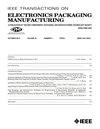Effects of Anisotropic Conductive Film Viscosity on ACF Fillet Formation and Chip-On-Board Packages
IEEE Transactions on Electronics Packaging Manufacturing
Pub Date : 2009-03-31
DOI:10.1109/TEPM.2009.2015288
引用次数: 17
Abstract
In this paper, the effects of anisotropic conductive film (ACF) viscosity on ACF fillet formation and, ultimately, on the pressure cooker test (PCT) reliability of ACF flip chip assemblies were investigated. The ACF viscosity was controlled by varying the molecular weight of the epoxy materials. It was found that the ACF viscosity increased as the increase of molecular weight of the epoxy materials. However, there was little variation of the thermomechanical properties among the evaluated ACFs with different viscosites. Also, the results showed that the ACFs have no differences in moisture absorption rate, die adhesion strength, and degree-of-cure. In scanning electron microscopy images, the lower ACF viscosity resulted in the smoother ACF fillet shape and the higher fillet height. From the results of PCT, the ACF flip chip assembly with the smoother fillet shape showed better reliability in terms of contact resistance changes. After 130 h of PCT, the flip chip assembly with lower ACF viscosity also showed a lesser degree of delamination at the ACF/chip interface.各向异性导电膜粘度对ACF圆角形成和片上封装的影响
本文研究了各向异性导电膜(ACF)粘度对ACF倒片组件的夹角形成的影响,并最终对ACF倒装片组件的高压锅试验(PCT)可靠性进行了研究。通过改变环氧材料的分子量来控制ACF的粘度。结果表明,ACF的粘度随环氧材料分子量的增加而增加。然而,不同黏度的活性炭纤维的热力学性能变化不大。结果表明,活性炭纤维在吸湿率、模具粘接强度和固化程度上没有差异。在扫描电镜图像中,较低的ACF粘度导致ACF圆角形状更光滑,圆角高度更高。从PCT的结果来看,圆角形状更光滑的ACF倒装芯片在接触电阻变化方面表现出更好的可靠性。PCT 130 h后,ACF粘度较低的倒装芯片组件在ACF/芯片界面处也显示出较小程度的分层。
本文章由计算机程序翻译,如有差异,请以英文原文为准。
求助全文
约1分钟内获得全文
求助全文

 求助内容:
求助内容: 应助结果提醒方式:
应助结果提醒方式:


